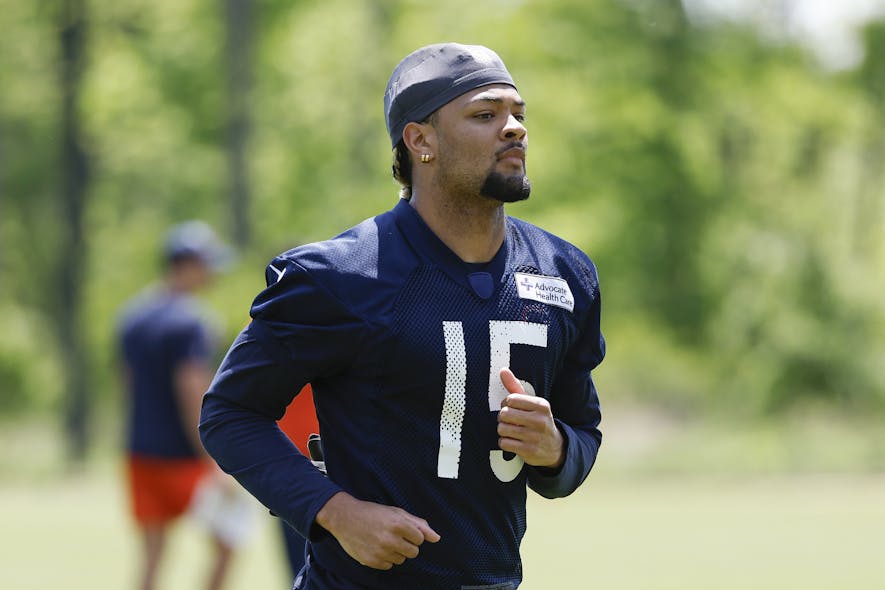Data-driven decision-making in fantasy football does not require a slavish devotion to numbers. The deeper down the rabbit hole you go, the more you appreciate how many questionable assumptions even the most robust analysis is built upon. The value of quantifying things that are inherently difficult to put numbers on is not all about finding answers. Instead, much of the benefit comes from a better understanding of which questions and assumptions are most important.
To some extent, we are all just guessing. The real goal is to make our guesses as educated as possible.
Within that context, today’s Dynasty Data article will explore concepts of data-driven dynasty decision-making through the lens of a single decision. You are on the clock in a dynasty startup draft, and the two best players on your board are Rome Odunze and Brandon Aiyuk. Who are you drafting?
Why Compare Odunze and Aiyuk?
There are thousands of different 1v1 scenarios I could have chosen to explore. Why pick these two players specifically?
- The two play the same position. Deciding between players at different positions involves many considerations and requires analysis specific to the league’s settings. Sticking to two players at the same position simplifies the analysis.
- The two play the same position, but the decision is less apples-to-apples than between two rookies (Rome Odunze vs. Malik Nabers) or two fifth-year wide receivers (Brandon Aiyuk vs. Tee Higgins). The fact that the two players are at different stages of their careers adds a layer of complexity that I find especially interesting.
- Many will face this Who Do I Draft? decision. I found myself on the clock last week pondering Odunze v. Aiyuk. Plus, the general consensus is that the two are valued exactly the same. If you check KeepTradeCut, for example, the valuation of the two is nearly identical.
Exploring the Odunze vs. Aiyuk decision allows us to explore deeper ideas like burn rate, understanding long-term player value through shorter increments, and managing roster risk.
Short-Term Production
According to the Footballguys consensus projections, Brandon Aiyuk (14.8 fantasy PPG) is expected to outscore Rome Odunze (9.8 fantasy PPG) by about five fantasy PPG this season. This is a major part of any data-driven analysis and provides a strong starting point for the player comparison.
Other factors will favor Odunze, but we must balance those against the fact that Aiyuk will likely be the more productive fantasy player in 2024.
Burn Rate
Two weeks ago, I wrote about the dynasty burn rate. I hope you will check out the full article if you have not read it, but here is a quick summary of the concept:
- We can quantify the dynasty value of the incoming rookie class by using startup auction values. Something in the neighborhood of 15% of total startup auction dollars is spent on rookies. This means the average veteran loses 15% of his dynasty value throughout a season.
- This 15% burn rate is not the same across all positions and all experience levels. Some player groups (like rookie wide receivers) see their value increase (negative burn rate). In contrast, other player groups (especially older wide receivers and running backs) have higher burn rates than 15%.
For purposes of the Odunze-Aiyuk decision, we want to look back at the burn rate we calculated for rookies (class of 2023) in comparison to the burn rate for fifth-year wide receivers (class of 2019):
If you invested your 2023 dynasty startup auction dollars in rookie wide receivers, on average, those players are worth 53.4% more today than in your 2023 startup. If you invested your startup dollars in wide receivers entering their fifth NFL season, those players are worth (on average) 31.1% less today.
For the sake of argument, let’s say that Odunze and Aiyuk have the same burn rates in 2024 as receivers with their experience levels did last season; what would both be valued at on KeepTradeCut (“KTC”) at this time next year?
If Odunze’s value got the big bump typical of receivers entering Year 2, his KTC value heading into 2025 would be 8,675. If Aiyuk’s value takes a big drop, typical of a wide receiver entering Year 6, his KTC value heading into 2025 would be 3,954.
Many small-sample size caveats apply, and I am not comfortable taking one year’s worth of data and using it universally. However, the two big takeaways are true:
- If Rome Odunze does not completely fall on his face as a rookie, his value will likely increase over the next year.
- Brandon Aiyuk is quickly approaching the age and experience level at which his dynasty value will decline rapidly.
The projected 5.0 fantasy PPG gap in 2024 is essential. Is the short-term benefit to your 2024 lineup that drafting Aiyuk over Odunze should provide worth the potential value gap we expect to see between the two players after the season ends?
This article is more about helping you ask yourself the right questions than providing answers, and this is the biggest question to consider.
Continue reading this content with a ELITE subscription.
An ELITE subscription is required to access content for Dynasty leagues. If this league is not a Dynasty league, you can edit your leagues here.




